
Previous entry:
Racing a Cardboard Boat Against Time
Next Entry:
I Laugh at Your Pool Tragedy
Home:
One Truth For All
| Sun | Mon | Tue | Wed | Thu | Fri | Sat |
|---|---|---|---|---|---|---|
| 1 | 2 | 3 | 4 | 5 | ||
| 6 | 7 | 8 | 9 | 10 | 11 | 12 |
| 13 | 14 | 15 | 16 | 17 | 18 | 19 |
| 20 | 21 | 22 | 23 | 24 | 25 | 26 |
| 27 | 28 | 29 | 30 | 31 |
Archives
- May 2008
- April 2008
- March 2008
- February 2008
- December 2007
- November 2007
- October 2007
- September 2007
- August 2007
- July 2007
- May 2007
- April 2007
- March 2007
- February 2007
- December 2006
- November 2006
- October 2006
- September 2006
- August 2006
- July 2006
- June 2006
- May 2006
- April 2006
- March 2006
- February 2006
- January 2006
- December 2005
- November 2005
- October 2005
- September 2005
- August 2005
- July 2005
- June 2005
- May 2005
- April 2005
- March 2005
- February 2005
- January 2005
- December 2004
- November 2004
- October 2004
- September 2004
- August 2004
- July 2004
- June 2004
- May 2004
- April 2004
- March 2004
- February 2004
- January 2004
- December 1969
January 22, 2005
More Cardboard Boats
This is probably my last entry ever, as I prepare to meet my watery end tomorrow afternoon. So I figured it was a good time to show some boat pictures from our boat show this afternoon, and talk about matters of boat design.
(edited to add some more comments on boat design knowledge.)
...
First, a peek at the overall show. Lots of boats (three class of about 18 each are participating, after all). Most of them are pretty decent designs, and will get their paddlers across the pool twice, which is the requirement for the project. I'll show you some of the bad designs in a moment.
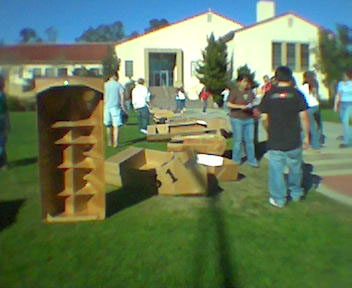
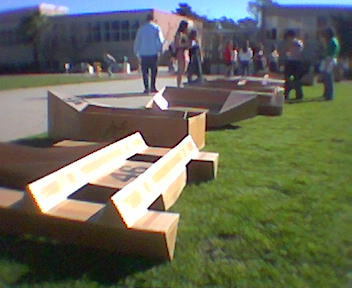
There's not a lot of room for new discoveries in boat design. We pretty much know what floats and what sinks, and what stays upright and what doesn't. There's refinement and tweaking, but I'm guessing just about nobody is going to come up with a new, innovative boat design that is not basically based on one of the many existing designs.
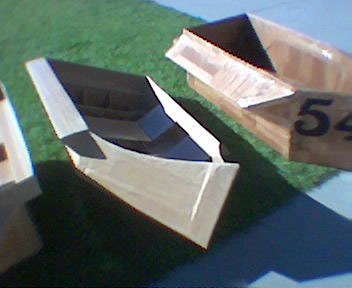
This is what works in a cardboard boat: a pointy end (to keep you going straight ahead), a wide flat bottom (to keep you stable), and sides that are high enough to keep the water out but low enough to allow you to paddle. Cardboard boats (within the parameters of this contest) are best paddled with a pair of hand paddles, rather than a canoe paddle or a kayak paddle, because they have very little underwater to keep the canoe pointed straight ahead, so the two hand paddles makes sure each stroke moves you forward, rather than turning you.
I've purchased two ping-pong paddles for this purpose.
So, on to my bets for disasters tomorrow. First up, the Barrel:
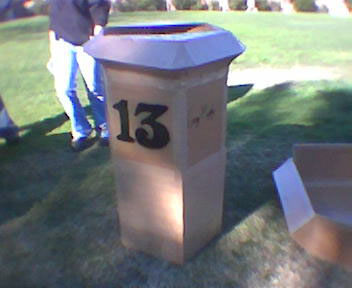
I do not know what this guy was thinking. Not only is this never going to stay upright, but he didn't put any reinforcement on the bottom, so he's going right through. I wish he were in my heat so I could flail helplessly unnoticed.
Then we have people who simply do not understand weight distribution over water:
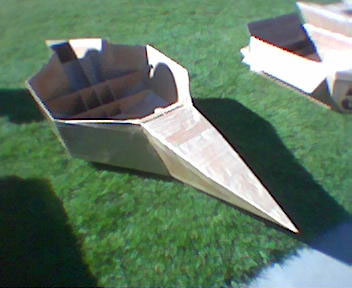
There's a very simple principle in physics which says that the total buoyant force is equal to the weight of the water displaced by the object. This buoyant force is distributed evenly across the area of the object. If you place a point load in the center of a beam that is evenly loaded in opposition to that load, you get bending at the ends. So you either want to have pretty much all of the displacement of your boat right where the weight of your body is (as in a corracle), or you need to stiffen the boat along its length so it resists that bending (as in a canoe or kayak) or you want to place all of your weight at one end (can't think of the name of an example).
Otherwise the boat bends in half when you get into it and water pours in.
Anyway.
One of the design requirements of this project was that we can't get our feet wet. I'm guessing, based on this design, that this person is going to get more than just his feet wet.
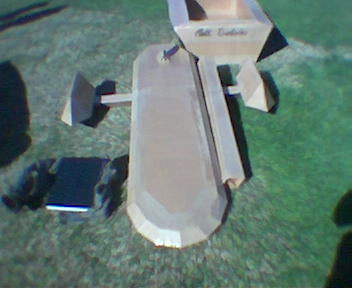
A cubic foot of water weighs a little under 62 and a half pounds. So a 150 pound human (as I'm guessing the guy who made this is) needs around two and a half cubic feet of boat at a bare minimum to displace enough water to stay afloat, without taking into account things like splashing or wobbling. I don't really see that much boat here. Not after those pontoons fall off, which they will do instantly.
We're now working our way into pontoon boat territory. We watched a couple old videos of this contest from previous years, and in those videos, pontoon boats went down over and over, breaking in half because of the unbalanced loading I mentioned earlier. This boat's flimsy outriggers fall into the same "failed to learn much in physics" category. When they break off from the force of the water pushing up on them, there will be two large holes in each side of the boat for water to get into the cardboard. And the boat doesn't look very strong, either. There's nothing to keep the sides out when the water is pushing in on them.
(One of the challenges in boatbuilding is that the forces that act on the boat when you're working on it are the opposite of the forces that act on the boat when it's being used.)
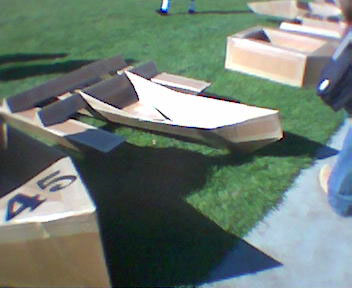
Here's our first pontoon. And I know something you don't know: she didn't reinforce those pontoons at all, because she ran out of material. Now, the boat may still stay together in the pool, but she's got to turn it around at the other end. This design works really well for going straight ahead (assuming watertightness, natch), but not so good for turning. That's because any large plane under the water will resist turning in that direction. Large ocean-going boats are made very linear so they tend to just go straight ahead without stopping. We've got to go 25 meters. Having a boat that doesn't want to turn at all is a major liability.
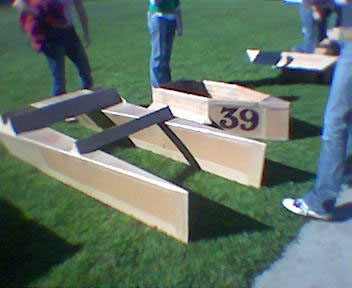
The merit of a pontoon boat is entirely in what holds the two pontoons together. This boat is bending the wrong way to resist water pushing up on it effectively.
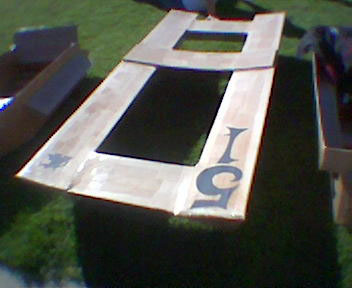
Oh, heavens.
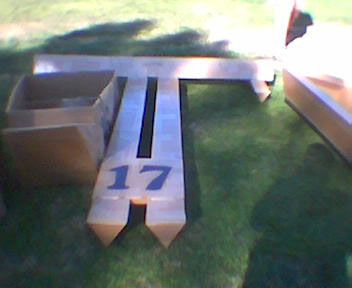
I love this boat. Take a pontoon boat, and make it better by... making the pontoons open? Are you crazy? Water gets into those things and the boat just falls apart. Not to mention that this is some of the sloppiest boatmaking I've ever seen.
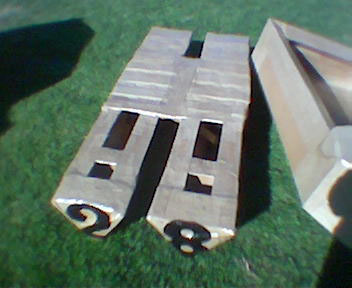
I'm pretty sure this boat is not going to behave like its builder thinks it will. For one thing, it looks really wobbly to me, which is exactly not what you want from a pontoon boat. In general, in boat design you want to get as much of your weight under the water as possible. This is why most boats have pointed bottoms or even heavy weights on the bottom. It keeps you from overturning. Anything that approximates a log will behave like that old county fair log-rolling contest, which means dunk-o-rama.
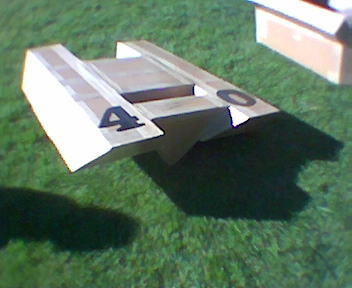
A twofer. We have a weird, ungainly pontoon boat (how the heck are you going to hold onto that thing while paddling? and a flimsy boat with flimsy bits sticking out of it. I'll wait and see on the boat; it could work. But that pontoon boat is going nowhere.
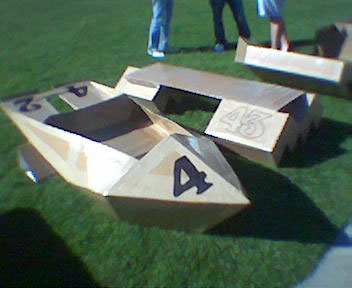
Well, off to bed. Tomorrow's a busy day: writing test in the morning, boat race in the afternoon, possible quick trip up to the Bay Area in the evening (which would be much easier if I have shed this earthly body, although that would make it harder for me to bring Noel that book on construction detailing I promised him).
Posted by ayse on 01/22/05 at 12:05 AM